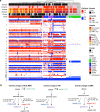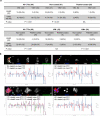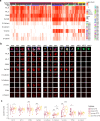Identification of epithelial and mesenchymal circulating tumor cells in clonal lineage of an aggressive prostate cancer case
- PMID: 35729213
- PMCID: PMC9213535
- DOI: 10.1038/s41698-022-00289-1
Identification of epithelial and mesenchymal circulating tumor cells in clonal lineage of an aggressive prostate cancer case
Abstract
Little is known about the complexity and plasticity of circulating tumor cell (CTC) biology in different compartments of the fluid microenvironment during tumor metastasis. Here we integrated phenomics, genomics, and targeted proteomics to characterize CTC phenotypic and genotypic heterogeneity in paired peripheral blood (PB) and bone marrow aspirate (BMA) from a metastatic prostate cancer patient following the rapid disease progression, using the High-Definition Single Cell Assay 3.0 (HDSCA3.0). Uniquely, we identified a subgroup of genetically clonal CTCs that acquired a mesenchymal-like state and its presence was significantly associated with one subclone that emerged along the clonal lineage. Higher CTC abundance and phenotypic diversity were observed in the BMA than PB and differences in genomic alterations were also identified between the two compartments demonstrating spatial heterogeneity. Single cell copy number profiling further detected clonal heterogeneity within clusters of CTCs (also known as microemboli or aggregates) as well as phenotypic variations by targeted proteomics. Overall, these results identify epithelial and mesenchymal CTCs in the clonal lineage of an aggressive prostate cancer case and also demonstrate a single cell multi-omic approach to deconvolute the heterogeneity and association of CTC phenotype and genotype in multi-medium liquid biopsies of metastatic prostate cancer.
© 2022. The Author(s).
Conflict of interest statement
P.K., J.H., and A.K. hold ownership interest (including patents) in, and P.K. and J.H. hold advisory roles a consultant to Epic Sciences. S.C., C.R-V., N.M., A.K., J.H. and P.K. are royalty recipients on related technology licensed to Epic Sciences for development. No potential competing interests were disclosed by the other authors.
Figures





Similar articles
-
Diversity of Epithelial-Mesenchymal Phenotypes in Circulating Tumour Cells from Prostate Cancer Patient-Derived Xenograft Models.Cancers (Basel). 2021 Jun 1;13(11):2750. doi: 10.3390/cancers13112750. Cancers (Basel). 2021. PMID: 34206049 Free PMC article.
-
Clonal diversity revealed by morphoproteomic and copy number profiles of single prostate cancer cells at diagnosis.Converg Sci Phys Oncol. 2018 Mar;4(1):015003. doi: 10.1088/2057-1739/aaa00b. Epub 2018 Jan 16. Converg Sci Phys Oncol. 2018. PMID: 32670616 Free PMC article.
-
Chromosomal Instability Estimation Based on Next Generation Sequencing and Single Cell Genome Wide Copy Number Variation Analysis.PLoS One. 2016 Nov 16;11(11):e0165089. doi: 10.1371/journal.pone.0165089. eCollection 2016. PLoS One. 2016. PMID: 27851748 Free PMC article.
-
Circulating tumor microemboli: Progress in molecular understanding and enrichment technologies.Biotechnol Adv. 2018 Jul-Aug;36(4):1367-1389. doi: 10.1016/j.biotechadv.2018.05.002. Epub 2018 May 18. Biotechnol Adv. 2018. PMID: 29753882 Review.
-
Circulating tumor cell as the functional aspect of liquid biopsy to understand the metastatic cascade in solid cancer.Mol Aspects Med. 2020 Apr;72:100816. doi: 10.1016/j.mam.2019.07.008. Epub 2019 Aug 21. Mol Aspects Med. 2020. PMID: 31377345 Review.
Cited by
-
Circulation of rare events in the liquid biopsy for early detection of lung mass lesions.Thorac Cancer. 2024 Oct;15(29):2100-2109. doi: 10.1111/1759-7714.15429. Epub 2024 Sep 4. Thorac Cancer. 2024. PMID: 39233479 Free PMC article.
-
Resolving tumor evolution: a phylogenetic approach.J Natl Cancer Cent. 2024 Mar 21;4(2):97-106. doi: 10.1016/j.jncc.2024.03.001. eCollection 2024 Jun. J Natl Cancer Cent. 2024. PMID: 39282584 Free PMC article. Review.
-
Determining the efficacy of ExThera Seraph100 blood filtration in patients diagnosed with pancreatic cancer through the liquid biopsy.BJC Rep. 2024 Jun 27;2(1):47. doi: 10.1038/s44276-024-00069-3. BJC Rep. 2024. PMID: 39516545 Free PMC article.
-
Contrastive Representation Learning for Single Cell Phenotyping in Whole Slide Imaging of Enrichment-free Liquid Biopsy.bioRxiv [Preprint]. 2025 May 24:2025.05.21.655334. doi: 10.1101/2025.05.21.655334. bioRxiv. 2025. PMID: 40475442 Free PMC article. Preprint.
-
Simultaneous expression of epithelial and immune cell markers in circulating tumor cells identified in patients with stage 4 breast cancer.Commun Med (Lond). 2025 Jul 24;5(1):309. doi: 10.1038/s43856-025-01024-0. Commun Med (Lond). 2025. PMID: 40707771 Free PMC article.
References
Grants and funding
LinkOut - more resources
Full Text Sources

